Philodendron Spiritus Sancti is still the holy grail of plant ownership.
If you think Monstera Obliqua and Monstera adansonii Variegata are rare, hard to get, and expensive, Philodendron Spiritus Sancti tops them in all three aspects.
The plant is found in Espirito Santo near the town of Domingos Martins in Brazil, and it is said that only a handful of plants are left in the wild.
There are probably more plants in cultivation that are left in the wild.
Especially now that Philodendron Spiritus Sancti has been successfully tissue cultured (TC) in Thailand.
This leads to more affordable plants, but we are still talking lower four digits.
I will do my best to share as much information as possible in this blog post.
Table of Contents
Philodendron Spiritus Sancti Care
Philodendron Spiritus Sancti grows best in well-draining airy, porous soil and stays slightly humid. A good mix includes leaves, shredded mosses, little soil, orchid bark, and charcoal. Keep the temperature between 66 – 76°F (19-24°C). Keep the humidity at around 80% for natural conditions. This plant needs very little fertilizer now and then.
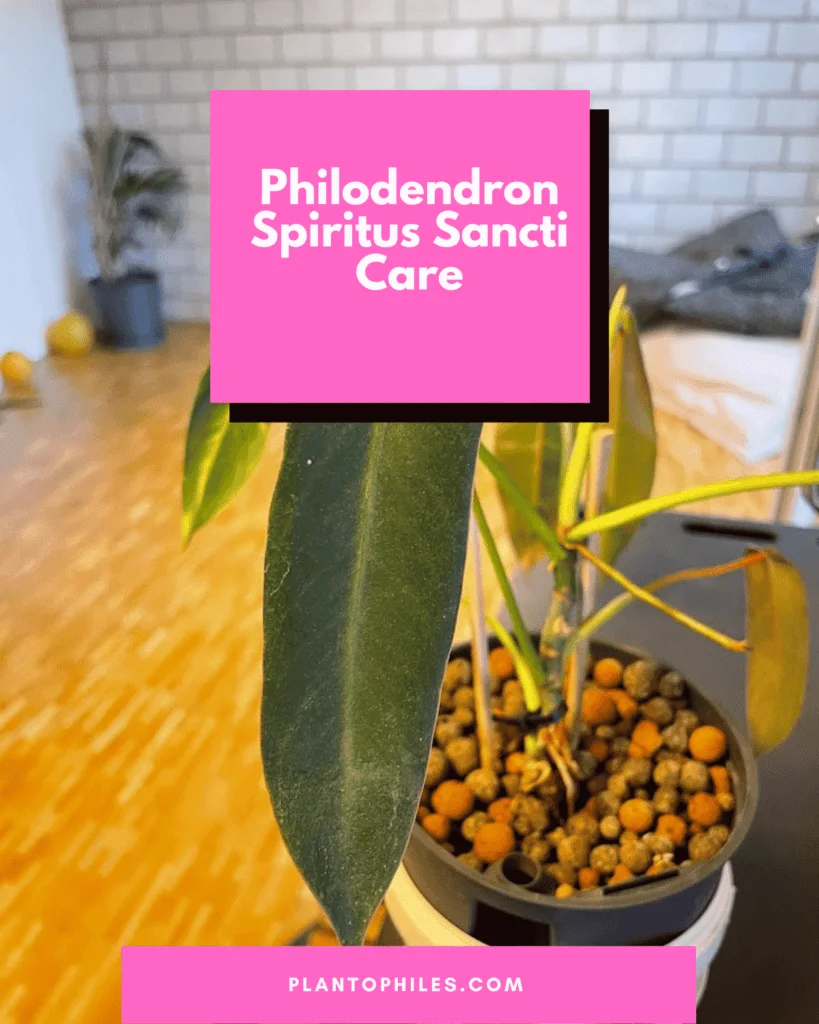
Spiritus Sancti plant
This plant is rather large, with pendent leaves up to 29” inches (74 cm). Philodendron Spiritus Sancti is a hemiepiphyte.
A hemiepiphyte is a plant that spends most of its life as an epiphyte, according to the Annals of Botany.
Primary hemiepiphytes send down roots to the ground.
Its seeds germinate in the tree canopy and begin their lives as an epiphyte.
Epiphytes are organisms that can live on the surface of other plants.
They take in nutrients from the air, rainwater, water, and debris, such as fallen leaves.
Its leaves are 22- 29 inches long (56-74 cm) and have a dark green, dull color with a width of 4.5 – 4.9 inches (11-12.5 cm).
The petioles – a name for the stalks that attach a leaf to its stem – are between 12 and 24 inches long.
The leaf blades are primarily thin with 4 lateral veins and have an elongated triangular shape.
The leaves shape looks somewhat like the Philodendron Spiritus Sancti leaves have bunny ears.
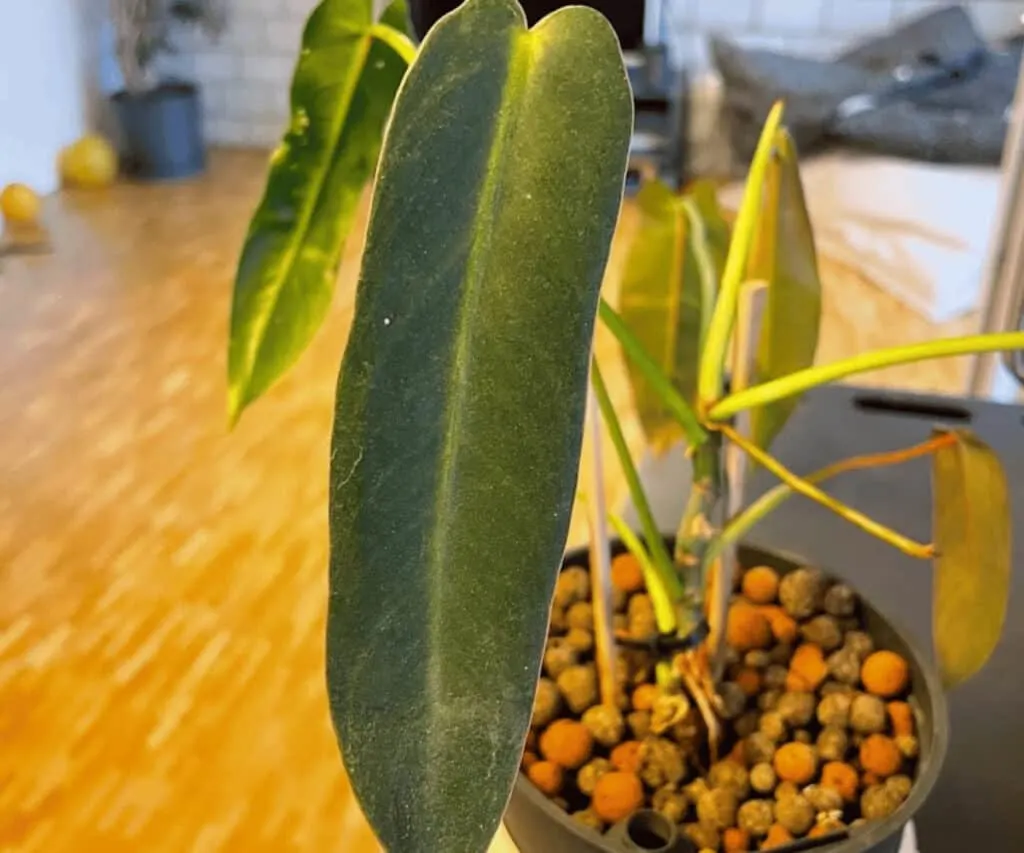
Philodendron Spiritus Sancti in the Wild
You find Philodendron Spiritus Sancti at an elevation of about 800 meters close to the Atlantic Ocean, northeast of Rio de Janeiro, Brazil.
The Philodendron SS is said to be almost extinct in the wild and is certainly endangered, as only a handful of plants are known to remain in its natural habitat.
The described location is also the only location it has ever been found.
The remaining specimen in situ are all located on a privately known land called the Kautsky farm.
It is sad but true to state that many more Spiritus Sancti is found in cultivation than in the wild.
But do not get me wrong, this Philodendron is rare and hard to find.
It will probably never be sold in your common nursery or garden center.
Philodendron Spiritus Sancti Care Guide
Interestingly the Philodendron Spiritus Sancti care is said by at least some growers to be rather easy to care for, unlike the care for Monstera Obliqua, a rather finicky leafy friend that needs the right levels of humidity and yellows/browns if you provide too much or too little light or if the nutrient intake is not in check.
Others say it’s easy to grow when you know how to prevent its roots from rotting.
Based on my experience growing Philodendron Spiritus Sancti, I faced no specific problems or issues.
My setup consists of an enclosed plastic box in a grow tent with humidity above 90% and a heat mat underneath.
I use airy, well-draining soil consisting of potting soil, perlite, chunky stones, and leca.
But let’s look at Philodendron Spiritus Sancti care in more detail.
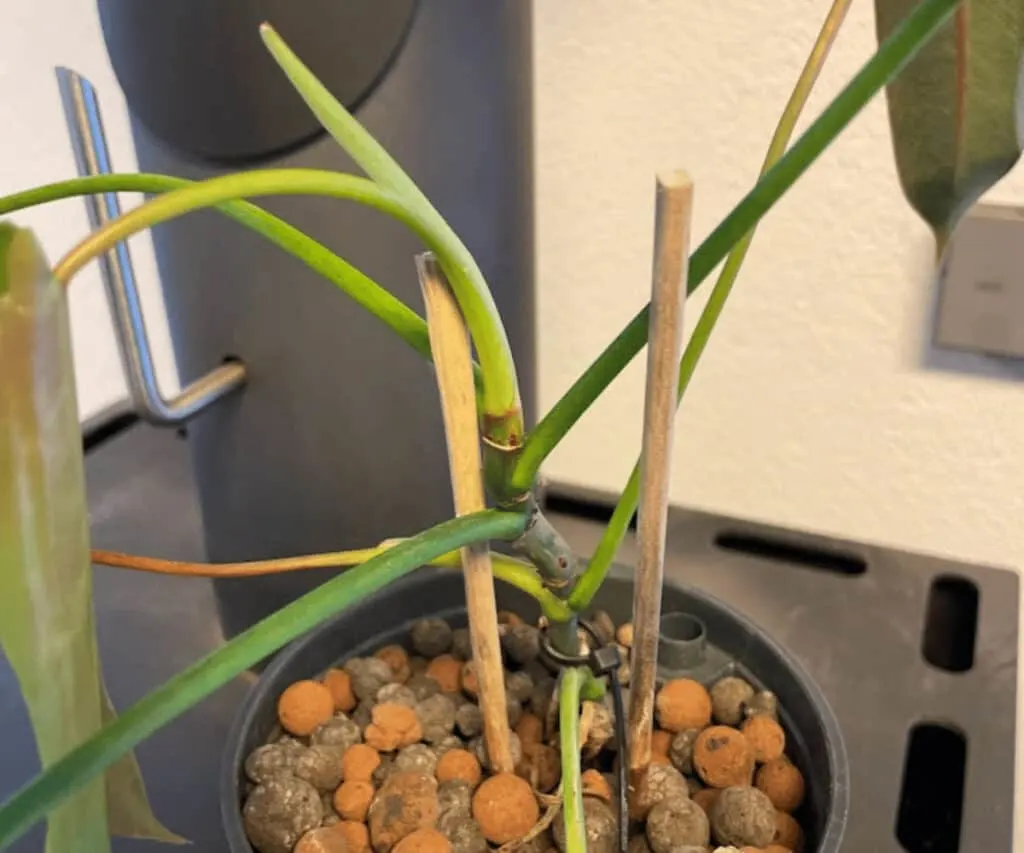
Soil
Philodendron Spiritus Sancti needs an airy soil mix best achieved by mixing leaves, shredded mosses, little soil, orchid bark, and charcoal. The mix needs to be extremely well-draining and porous.
Some growers grow the Spiritus Sancti in bare Spaghnum Moss or with mixed-in coco chips and perlite.
It has to drain quickly but also hold some moisture for the plant roots to absorb.
You are looking for air pockets created by a chunky soil mixture. The Spiritus Sancti is very prone to root rot.
Light
The Philodendron Spiritus Sancti prefers bright indirect light.
A few hours of direct sunlight in the morning is fine, but most light needs to be indirect.
Ensure the light is received from above as this Philodendron directs its leaves toward the light source.
Having the light come in from one side only will lead to a strange-looking plant unless you are willing to rotate its’ pot frequently.
But that could stress the plant and lead to other problems.
So directing the light to the plant from above is suggested.
Watering
Keeping your Philodendron Spiritus Sancti moist at all times is advised. Look for a wet feel to the touch. It should not stand in water or, even worse, soggy soil.
That would quickly lead to you having to say bye-bye to your beautiful pendant friend and, most likely, to a couple of grand.
Also, in terms of watering, I advise keeping it consistent.
Having roots drying up for too long or keeping them too wet and they are gone before you know it.
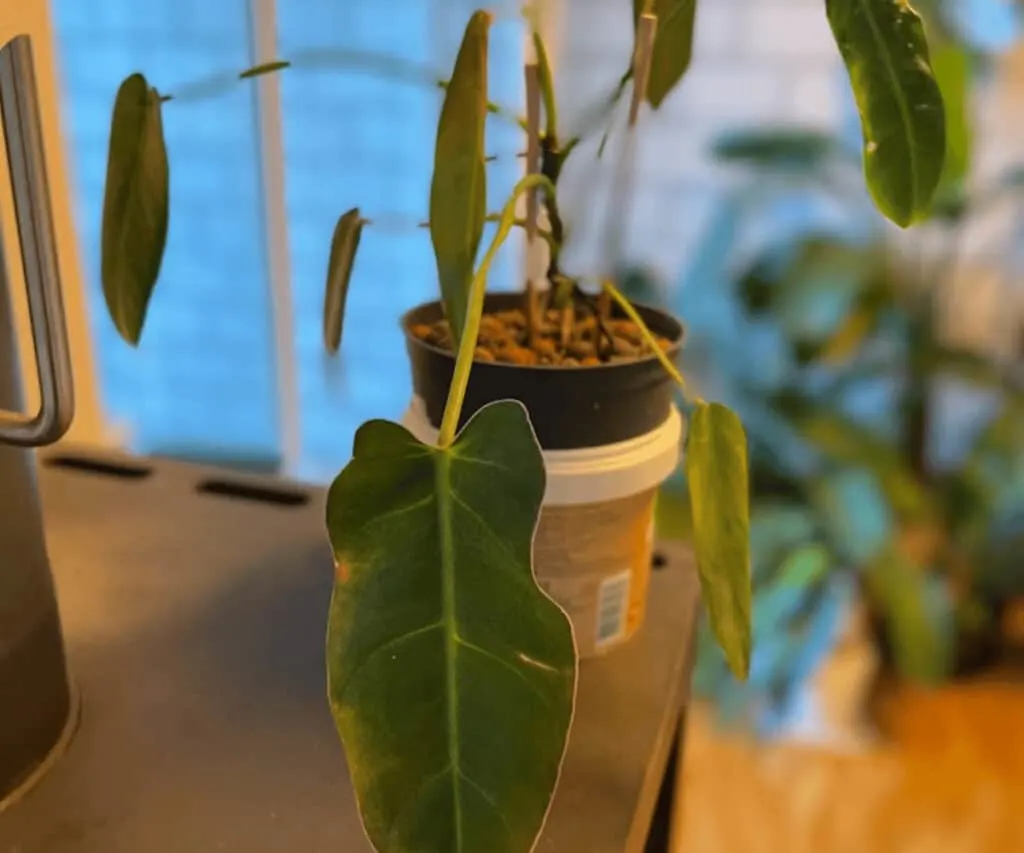
Temperature
A temperature between 66 – 76°F (19-24°C ) for a Philodendron Spiritus Sancti will mimic its natural habitat, at least in average temperatures.
This plant doesn’t like big swings in temperature either.
Holding a constant temperature is key to caring for this aroid successfully.
Not much is written about the ideal temperature to grow this beautiful plant.
Whenever this is the case it might make sense to check the climate table where the plant is found in situ.
In this case, it is Domingo Martins in Espirito Santo’s estate in Brazil. The town is 567 above ground and has a tropical climate.
The average temperature is 70.7° Fahrenheit (21.5° Celsius). The highest average temperature is 75.74° Fahrenheit or 24.3° Celcisus, whereas the lowest average temperature is 66.02° Fahrenheit 18.9° Celsius.
Humidity
The average humidity in its natural habitat is just below 80%.
This plant is surprisingly not an extreme sucker for extreme humidity and will also do well in average humidity in your house, depending on where you live.
It will not appreciate big humidity changes and likes humidity to be kept at a constant level.
A humidity level of at least 20% seems to be sufficient.
Fertilizer
As an epiphyte, this aroid is doing well with little fertilizer, as in the wild, it has to survive with what the wind, rain, water, and fallen leaves contain in terms of nutrients.
On the other hand, a sufficient amount of nutrients will ensure that your plant stays healthy and produces beautiful leaves, which might lead to an increased growth rate.
I recommend adding little to no fertilizer, depending on the water you are using for watering.
If you use distilled water, you must occasionally add liquid fertilizer.
Propagation
Propagating the Philodendron Spiritus Sancti seems to be a challenge.
Not so much the growing part of it but more the rooting of new cuttings.
For some reason, the rooting process takes a while, and new cuttings are not eager to root.
So before you chop your unicorn into pieces, air layering might be an excellent way to produce leaves before taking your scissors out.
However, challenging does not mean impossible, as many growers have propagated it before with success. Many collectors will be more than happy to buy it from you if you can part with a propagated plant.
Growth
Under good conditions, the Spiritus Sancti seems to be a good and vigorous grower, and 1-3 new leaves a month are not uncommon.
This Philodendron is a climber and grows best as an epiphyte.
Provide it with a stick or a moss pole to which you can attach it. It has pendent leaves that will be hanging down and can get rather large.
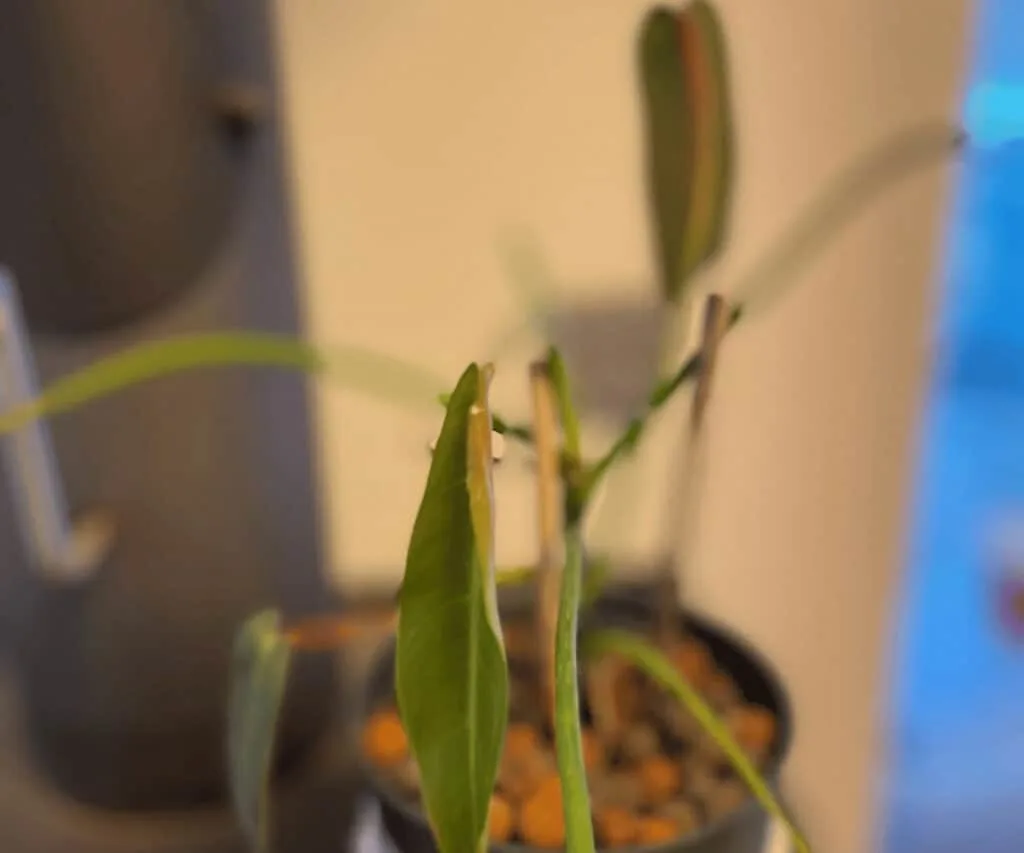
Potting
Provide it with a pot that allows for sufficient airflow. Proper drainage is also key as excess water needs to be able to drain quickly. So drainage holes in the bottom are a must.
Many growers use plastic pots and put holes into the pot’s side for better airflow.
In addition, a transparent plastic pot can be used to check the roots regularly without disturbing the plant.
As the leaves are pendent and grow rather large, you must think of a solution that allows the leaves to hang in the air.
So you must provide a podium or put the Spiritus Sancti into a hanging basket.
If you ever acquire or are already caring for a Philodendron Spiritus Sancti, I would love to hear and learn from you and exchange care tips.
Thank you, and good luck with your Spiritus Sancti. Amen.
Frequently Asked Questions About Spiritus Sancti Philodendron
Where can I buy a Philodendron Spiritus Sancti?
The Spiritus Sancti is certainly one of the rarest Philodendron species and is still hard to find. 2-3 years ago, it was almost impossible.
One of the nurseries in the US that has this species available from time to time is NSE Tropicals.
But mostly, you will just see “out of stock,” as there is only a very limited number of plants available each year.
If you are not living in the US or if NSE Tropicals doesn’t have a Philodendron Spiritus Sancti available, there are nurseries in Thailand and the Philippines that might have it in stock.
Apart from flying over, the best thing to get in touch with is to screen Social Media (Facebook & Instagram), and screen for Spiritus Sancti-related posts and images.
And, of course, there always is the option to buy from an aroid collector or houseplant enthusiast.
The challenge, apart from the price tag, will be finding someone that has it available (propagation seems to be a challenge) willing to sell to you.
In addition, some specimens have been sold on eBay, auction-style.
This way of acquiring a plant probably needs the deepest pockets as you will compete with other aspiring plant collectors that would love the add the #1 unicorn to their collection.
A recent winning bid on eBay for a Spiritus Sancti was almost $6000.
The IAS – International Aroid Society sometimes sells specimens in annual auctions, usually held on the 3rd weekend of September.
The last auction was in 2020 at Fairchild Tropical Botanic Garden in Miami.
UPDATE: Philodendron Spiritus Sancti has been successfully tissue cultured in Thailand.
This is bringing down prices considerably.
I have seen prices in Thailand around 1000 dollars per plant.
Once the plantlets leave Thailand and get to the US or Europe, prices at least double.
How much does a Philodendron Spiritus Sancti cost?
Prices have recently risen astronomically and followed the pattern of price tag increases of plants such as the Monstera Obliqua and the Monstera adansonii Variegata.
The lower the supply and the higher the demand, the more expensive the plant is. Add in the effect of creating envy on Social Media such as Instagram and Facebook through posting pictures and an auction on eBay where a specimen of a specific plant has sold for a high price, and you end up with the perfect brew.
The price action how we see it:
Pre 2019 <$1000 for a Spiritus Sancti
2019 – Around $1000 – $1500
2020 – After the recent eBay Auction (a grown Spiritus Sancti sold for almost $6000). The price for a Spiritus Sancti with 3-5 leaves >=$3000
2022 – $1000 – $2500 Tissue Cultured Plants (TC)
2023 – $300 per plant or less
Will the price for a Philodendron Spiritus Sancti go down eventually?
Yes, it eventually will. But we are talking about years and not months. It is more likely that the price will either stay stable or go up further as demand for Spiritus Sancti is increasing. More and more plant enthusiasts enter the hobby and hear about the rarity of this aroid for the first time. For most, this is still unicorn “houseplant” #1.
Should I buy Philodendron Spiritus Sancti seeds on the internet?
Never buy seeds over the internet (some exceptions apply, such as herb seeds and cacti seeds, among others).
The chance of being scammed is very high. Specifically, not Philodendron Spiritus Sancti seeds; you will be scammed 100%.
Is Philodendron Spiritus Sancti difficult to care for?
Interestingly, many describe the Spiritus Sancti as rather easy to care for.
This is unlike the Monstera obliqua, which needs constant high humidity and is always suffering from some kind of nutrient deficiency and is not holding back in showing this by changing leaf color, dropping leaves, dry leaves, etc. (at least for us).
It can be such as drama queen.
We heard that the Philodendron Spiritus Sancti is – apart from being very prone to root rot – quite easy to care for.
Once you have covered your bases by providing an airy substrate mix, use a pot that allows great airflow (e.g. holes in the pot’s side), and put the plant where it is bright but with limited direct sun; it is supposed to be a happy camper.
At least, that is what we heard.
Like most aroids, specifically Philodendron, the Spiritus Sancti loves humidity rather in the air than in the soil constantly, leading to root rot.
So it is fair to conclude that compared to other rare aroids, the Spiritus Sancti is rather easy to care for.
Is Philodendron Santa Leopoldina the same as Philodendron Spiritus Sancti?
In most cases, if not all cases, the Philodendron Spiritus Sancti is not the same as a Philodendron Santa Leopoldina as this is just a common name and could, therefore, be used for almost any plant with long pendant leaves.
There are several species referred to as Santa Leopoldina. It makes sense to use your common sense.
When a plant is sold for $30 and is called Santa Leopoldina, it will not be a genuine Spiritus Sancti. It is as simple as that.
If you own a Philodendron Spiritus Sancti, let me know how you care for it!

Daniel has been a plant enthusiast for over 20 years. He owns hundreds of houseplants and prepares for the chili growing seasons yearly with great anticipation. His favorite plants are plant species in the Araceae family, such as Monstera, Philodendron, and Anthurium. He also loves gardening and is growing hot peppers, tomatoes, and many more vegetables.


